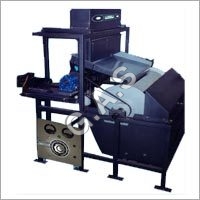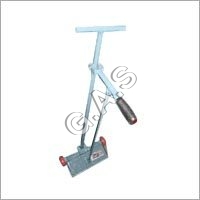Magnetic Pulleys
Magnetic Pulleys Specification
- Composite
- Magnet Assembly, Mild Steel Construction
- Power Supply
- Electrical (for motorized pulley types)
- Power
- 0.5 HP to 3 HP (for drive motor, if supplied)
- Material
- Mild Steel Shell, Magnet Core
- Frequency
- 50/60 Hz
- Application
- Separation of ferrous metals from bulk material, Recycling, Mining, Food, Plastic, and Chemical Industries
- Surface Finish
- Painted and polished
- Magnet Grade
- Y30/Y35 (Ferrite) or N42/N52 (Neodymium)
- Product Type
- Magnetic Pulley
- Magnet Category
- Industrial Separation Magnets
- Magnet Type
- Permanent Ferrite or Rare Earth Magnets
- Shape
- Cylindrical
- Size Range
- Diameter: 150 mm to 1200 mm, Length: 300 mm to 2000 mm
- Color
- Blue/Black/Custom
- Capacity
- Up to 100 tons per hour (depending on size and application)
Magnetic Pulleys Trade Information
- Minimum Order Quantity
- 1 Piece
- Supply Ability
- 10 Pieces Per Month
- Delivery Time
- 1 Week
About Magnetic Pulleys
We are an unparalleled name engaged in offering premium quality Magnetic Pulleys that are used as head pulley in belt conveyors for removing ferrous contaminants from material flow. Available in four different hub styles namely extended hubs, flush hubs, recessed hubs and with out hubs, offered pulleys are available with or without lagging and with crowned or flat faces. Further, these are equipped with pulley shafts that are removable mild steel or stainless steel components. Further, the standard size of these Magnetic Pulleys varies from 4 diameter by 10 face width and can be availed at most competitive price range.
Features:
- Unmatched performance
- Sturdy construction
- Dimensional stability
- Long service life
- 304 stainless steel faces
- Removable mild steel shaft
- Four hub styles
- Flat face
- Keyway and set screws.
Efficient Magnetic Separation Technology
Leverage high-performance magnetic pulleys, designed with radial or axial pole construction, to ensure consistent separation of ferrous materials in demanding environments. Engineered for continuous operation, these units handle bulk throughput with precisionenhancing operational productivity across recycling, mining, and industrial processing sectors.
Versatile Drive and Customization Options
Choose between direct or gear motor-driven systems to best suit your application and site requirements. With broad compatibility for belt speeds from 0.5 to 4.0 m/s and a customizable range in size, length, and magnetic grade, these pulleys integrate effortlessly into new or existing conveyor systemsdelivering tailored solutions for every industry need.
Low Maintenance, Durable Performance
Constructed from high-quality mild steel with secure magnet assemblies, our pulleys require minimal maintenance and offer IP55 or higher protection (motorized units). This durable design ensures reliable operation in harsh conditions, reduces downtime, and extends equipment service life for continuous, worry-free metal separation.
FAQs of Magnetic Pulleys:
Q: How do magnetic pulleys separate ferrous metals from bulk material?
A: Magnetic pulleys use strong permanent magnets arranged in radial or axial poles. As bulk material moves over the rotating pulley, the magnetic field attracts and lifts ferrous particles, which are then discharged separately, ensuring efficient removal from the product stream.Q: What are the main applications for these magnetic pulleys?
A: These pulleys are widely used in recycling, mining, food processing, plastics, and chemical industries for the separation of ferrous contaminants from conveyor-transported bulk materials, improving product purity and protecting downstream equipment.Q: When should I choose a direct drive over a gear motor-driven magnetic pulley?
A: Direct drives are suitable for straightforward installations with lower torque requirements and simple maintenance, while gear motor-driven pulleys are ideal for higher torque settings and applications needing variable speed or heavier-duty handling.Q: Where can these pulleys be installed within a conveyor system?
A: Magnetic pulleys are typically installed at the head of conveyor belts to maximize ferrous separation during the discharge phase, making them effective as the final defense against metal contamination in processing lines.Q: What is the process for customizing a pulley to my conveyor specifications?
A: We offer full customization, including size, magnet grade, drive type, surface finish, and color. Provide your conveyors technical parameters, and our engineers will design a solution tailored to your application and capacity requirements.Q: How does the robust design of these pulleys minimize maintenance?
A: With a mild steel shell, secure magnet core assembly, IP55 or higher motor protection, and resistance to wear and environmental factors, these pulleys are constructed for longevity and require only occasional cleaning and inspection.Q: What are the key benefits of using these magnetic pulleys for industrial separation?
A: Key benefits include reliable ferrous separation, reduced contamination, improved product quality, extended machinery life, and increased operational efficiencyachieved with minimal maintenance and full compatibility across various industries.

Price:
- 50
- 100
- 200
- 250
- 500
- 1000+
More Products in Magnetic Equipments Category
Hump Magnetic Separators
Price 20000 INR / Piece
Minimum Order Quantity : 1 Piece
Magnet Grade : N35, N38 or Custom Grade
Color : Industrial Grey / Custom coating
Shape : Other, Hump (Angular) Construction
Magnet Category : Other, High Intensity Ferrite or Rare Earth (Neodymium)
Single Drum Magnetic Separator
Price 100000 INR
Minimum Order Quantity : 1 Piece
Magnet Grade : Y30 / NdFeB
Color : Blue/Grey
Shape : Other, Cylindrical
Magnet Category : Other, Ferrite / Rare Earth
Magnetic Sweeper
Price 5000 INR
Minimum Order Quantity : 1 Piece
Magnet Grade : NdFeB (Neodymium) / Ferrite
Color : Silver with Black Handle
Shape : Other, Rectangular Bar
Magnet Category : Other, Industrial Magnet
Permanent Plate Magnets
Price 10000 INR
Minimum Order Quantity : 1 Piece
Magnet Grade : Rare Earth (NdFeB) or Ceramic/Ferrite grade as specified
Color : Silver/Metallic with blue or grey painted frame
Shape : Other, Rectangular Plate
Magnet Category : Other, Industrial Magnets

 Send Inquiry
Send Inquiry






 Send Inquiry
Send Inquiry Send SMS
Send SMS